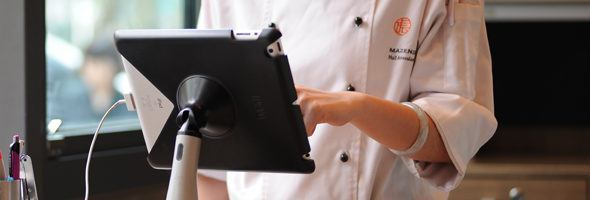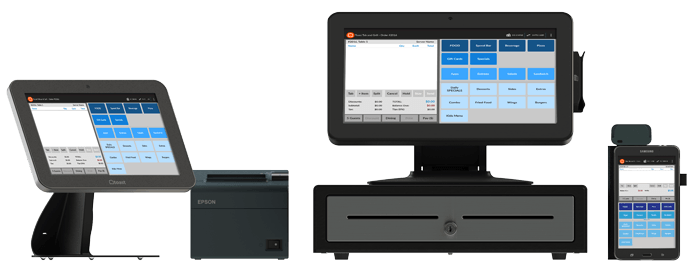Soon, Traditional Restaurant Management Systems Will Be Toast

A Fenway-based start-up is attempting to deliver innovative software technology to the restaurant industry and digitize the way restaurants run their businesses.
State of the Stone-Age Restaurant Industry
In 2011, the Financial Times wrote that “capturing the new value in the digital space over the next several years will depend on the ability of companies…to develop strategies that bring them closer” to customers.1 Five years later, the customer-service-heavy industry, restaurants, ranks last out of 15 sectors in industry digitization.2 Restaurants’ variable nature, high degree of “hands-on” interaction with customers, and generally lower usage of technology all contribute to the industry’s technological lag. The big challenge with digitization of restaurants is that “tools have to work in the context of restaurant work: rarely in front of a computer, multilingual, and time strapped.”3 Restaurants’ current solutions for supply, labor, and cost management are fragmented and rudimentary at best. Existing technology programs are not optimized for restaurant owners, staff, or customers, as they focus on only one area, do not integrate easily with other systems, and do not leverage cloud connectivity.
Toast’s Solution
Born out of this industry’s vacuum, Toast attacks this issue and uses innovative technology to deliver a complete solution for the restaurant industry’s needs: operations, orders, customers, and employees.4 Toast’s founders realized that restaurants live and die by their point-of-sale (POS) system, most versions of which were built back in the 80s and 90s, “not cloud-based, not-mobile, and not enabled for customers who are used to tablets.”5 The company took advantage of this opening in the industry and created a multifunctional POS software platform complimented by hardware accessories, with easy installation and updates, real-time statistics, and off-site access for a more modern way of selling. Toast’s enterprise-grade infrastructure is easy to use and integrates into the restaurant’s P&L for greater visibility into the business and increased data collection and analysis. Target customers are full (table) service, quick service, bars / nightclubs, online ordering, and franchise restaurants, all of which can customize the software based on specific needs.
Key differentiators that are all part of Toast’s operating software platform include:
- Business Intelligence: The Toast Customer Relationship Management (CRM) software is integrated directly into the POS system, allowing restaurants to collect and integrate data from many sources so that they can more easily gain insight to perform customer segmentation and marketing. Detailed customer preferences like menu choices and payment methods are available on demand, greatly increasing the ease and speed of information flow. Not only does cloud-based technology like Toast’s help restaurants rely less on inefficient manual processes when monitoring various aspects of the business, but it also can help restauranteurs control price variance, conserve time, and considerably reduce category spend.6 Additionally, menu costing becomes much simpler and efficient with full transparency, and the software’s streamlined purchasing process can greatly contribute to reducing costs and bringing consistency.
- Inventory: The 2016 State of Small Business Report found that 48% of all small business do not track their inventory or use a manual process and furthermore that 25% of restaurants just use pen and paper for inventory management.7 Complimenting the intelligence reporting described above, Toast offers automatic and downloadable food cost, inventory variance, and menu engineering reports. Nationwide, millions of pounds of food are thrown away each day, and “4-10% of food purchased by a restaurant or foodservice operation is discarded before ever reaching a guest.”8 Because part of Toast’s customer promise is easy-to-use software, the inventory management tools are integrated alongside the POS reports, allowing restaurateurs to make decisions about menu and labor instantly.
- Performance Management: One of the key reasons many restaurants fail is because of poor planning and inattention to possible cost saving opportunities.6 At Toast, labor management software automatically tracks employees’ pay and productivity, with real-time reporting making it easier to take advantage of opportunities to reduce labor cost. The ability to instantly view this information also ensures that necessary activities are not overlooked during close-of-day tasks and decreases the time and complications of these actions.
Looking Forward
As technology advances, companies operating within the restaurant industry will have greater success in digitizing their businesses. Toast’s competition in its currently-fragmented landscape may increase substantially or demand for its services could decrease. As a result, to remain viable, the company could expand its offerings and work next with larger food service providers like schools or stadium complexes. Additionally, given that several insurance and fitness companies are developing ways to gather data on health-related behavior,9 Toast could partner with interested consumers to automatically send nutritional information based on menu items consumed or imbibed. The recognition that technology – “whether it takes the form of new POS systems for mobile wallets, on-demand delivery services, or bold social media strategies”10 – is critical for great restaurant experiences is the reason why Toast will be successful in changing the digitization dynamics of the industry if it remains innovative and expanding.
(791 Words)
Works Cited
- Standridge, David and Christopher Pencavel. “In the digital economy, the consumer remains king.” Financial Times, November 23, 2011. https://www.ft.com/content/d6124740-160f-11e1-a691-00144feabdc0.
- Friedrich, Roman, Florian Gröne, Alex Koster, and Matthew Le Merle. “Measuring industry digitization: Leaders and laggards in the digital economy.” Booz & Company (December 2011). http://www.strategyand.pwc.com/reports/measuring-industry-digitization-leaders-laggards, accessed November 2016.
- Feldman, Eli. “Why the Restaurant Industry is the Most Important Industry in Today’s America.” Medium, January 18, 2015. https://medium.com/@EliFeldman/why-the-restaurant-industry-is-the-most-important-industry-in-todays-america-6a819f8f0ac9#.tkz8b8lp4, accessed November 2016.
- Toast, Inc. https://pos.toasttab.com/, accessed November 2016.
- The Fenway. “Toast Pops Up in The Fenway: Hatch’s First Tenant Moves In.” http://thefenway.com/art-culture-business-events-real-estate-working/toast-pops-fenway-hatch%E2%80%99s-first-tenant-moves, accessed November 2016.
- “Digitization: The Role of Technology in Creating Restaurant Efficiency.” Modern Restaurant Management, October 24, 2016. http://www.modernrestaurantmanagement.com/%E2%80%A8digitization-the-role-of-technology-in-creating-restaurant-efficiency/, accessed November 2016.
- Wasp Barcode Technologies. “State of Small Business Report.” http://www.waspbarcode.com/small-business-report, accessed November 2016.
- National Restaurant Association. “Measuring food waste can bolster your bottom line.” http://www.restaurant.org/Manage-My-Restaurant/Operations/Back-of-House/Measuring-food-waste-can-bolster-your-bottom-line, accessed November 2016.
- Burkitt, Frank. “A Strategist’s Guide to the Internet of Things.” Strategy+Business: Winter 2014, Issue 77. http://www.strategy-business.com/article/00294?gko=a9303.
- Scott, Renae. “Digitize or Die: The Near Future of Quick Service.” QSR Magazine: July 2015. https://www.qsrmagazine.com/outside-insights/digitize-or-die-near-future-quick-service.




This is fascinating, Nick. Regarding business intelligence, I think restaurants would love the ability to pick more of their customers. During prime time like a Saturday night, the tab for four people at a nice restaurant in Boston could conceivably vary from $60 (four main courses like pasta with no appetizers, drinks or desserts) to $400+. Imagine if Toast’s POS system could integrate with OpenTable and limit reservation availability during certain time slots to customers who average a certain minimum spend. Given the low margins in the restaurant business and the high failure rate, helping restaurants get the most profitable customers at any given could revolutionize the business — although there are obviously moral and ethical concerns with allocating tables in this way.
Hey Nick – Thanks for this post. I have noticed POS software on iPads across restaurants in Boston (including my favorite, Tatte!) so it was interesting to read the above and dive a little deeper into the value proposition. One impact category I would add to the above is “Influencing consumer behavior”. A phenomenon known as “guild tipping” has sprung up as a result of these POS systems. Per Slate magazine, tipping behavior has increased as a result of electronic prompts at checkout. For example, in NYC taxi cabs, gratuities rose from 10% to 22% when they transitioned to an electronic system. You can read more about it here: http://www.slate.com/articles/business/moneybox/2014/03/starbucks_square_and_e_payments_do_new_point_of_payment_systems_increase.html. I can imagine that these products are also a useful feedback mechanism. I have seen on Square checkout, for example, a forced star rating at checkout. This is a great way to get quick consumer feedback without having to launch an extra surveying effort.
Great post, Nick. I think the inventory management feature is the biggest opportunity here. Similar to the Zenefits model (but with less legal issues), Toast can potentially even offer that feature for free or at a low cost, and charge suppliers for access to restaurants. Since most small business restaurants are somewhat resistant to new technology and are very budget conscious, this could be an effective way to get in the door.
While the data analytics and business intelligence offering sounds like very powerful tools for optimization, I wonder whether restaurant owners will have the appetite to review the data and do analysis like customer segmentation. Perhaps Toast will need to be somewhat prescriptive with operational recommendations rather than just surfacing the data to the end user.
Great post, Nick. Thanks for sharing! It seems that this Company has a unique ability to collect, analyze, and store data. You are right on about saying that most POS software and hardware is still from the 80s and 90s. The issue that Toast may face is that it is extremely difficult to sell POS systems to restaurants. They are extremely price sensitive, have slow buying cycles, and insist on having rugged hardware. There have been many innovative POS systems that have come before Toast, but restaurants typically keep their NCR hardware and Aloha software because it is “good enough”. Perhaps Toast’s ability to tackle procurement issues will be a key differentiator.
I’m curious how this is better than Square. Also, I saw that Open Table was moving into Mobile Payments. I wonder how that will impact the restaurant POS industry.
http://openforbusiness.opentable.com/insider-information/how-opentable-is-bringing-mobile-payments-to-more-restaurants-diners-with-aloha-pos-integration/